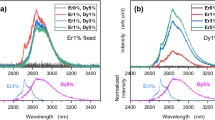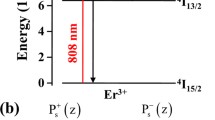Abstract
Dy3+-doped fluoride fiber lasers have important applications in environment monitoring, real-time sensing, and polymer processing. At present, achieving a high-efficiency and high-power Dy3+-doped fluoride fiber laser in the mid-infrared (mid-IR) region over 3 µm is a scientific and technological frontier. Typically, Dy3+-doped fluoride fiber lasers use a unidirectional pumping method, which suffers from the drawback of high thermal loading density on the fiber tips, thus limiting power scalability. In this study, a bi-directional in-band pumping scheme, to address the limitations of output power scaling and to enhance the efficiency of the Dy3+-doped fluoride fiber laser at 3.2 µm, is investigated numerically based on rate equations and propagation equations. Detailed simulation results reveal that the optical–optical efficiency of the bi-directional in-band pumped Dy3+-doped fluoride fiber laser can reach 75.1%, approaching the Stokes limit of 87.3%. The potential for further improvement of the efficiency of the Dy3+-doped fluoride fiber laser is also discussed. The bi-directional pumping scheme offers the intrinsic advantage of mitigating the thermal load on the fiber tips, unlike unidirectional pumping, in addition to its high efficiency. As a result, it is expected to significantly scale the power output of Dy3+-doped fluoride fiber lasers in the mid-IR regime.
摘要
掺镝氟化物光纤激光器在环境监测、实时传感和聚合物加工等方面具有重要应用。目前, 在>3 µm的中红外区域获得高效率、高功率的掺镝氟化物光纤激光是科技前沿领域。通常, 掺镝氟化物光纤激光器采用单向泵浦方案, 但其存在光纤端面高热负载密度的缺点, 限制了功率的提升。本研究基于速率方程和传输方程, 数值研究了一种双向同带泵浦方案, 旨在解决3.2 µm掺镝氟化物光纤激光器输出功率提升的限制, 并提升其效率。仿真结果表明, 双向同带泵浦的掺镝氟化物光纤激光器的光光效率可达75.1%, 接近斯托克斯极限87.3%。同时, 讨论了进一步提高掺镝氟化物光纤激光器效率的潜力。与单向泵浦相比, 双向泵浦方案除了高效率外, 还具有减轻光纤端面热负荷的固有优势。因此, 该方案有望显著提高掺镝氟化光纤激光器在中红外波段的输出功率。
Similar content being viewed by others
Data availability
The data that support the findings of this study are available from the corresponding authors upon reasonable request.
References
Amin Z, Majewski MR, Woodward RI, et al., 2020. Novel near-infrared pump wavelengths for dysprosium fiber lasers. J Lightw Technol, 38(20):5801–5808. https://doi.org/10.1109/JLT.2020.3004428
Aydin YO, Fortin V, Vallée R, et al., 2018. Towards power scaling of 2.8 µm fiber lasers. Opt Lett, 43(18):4542–4545. https://doi.org/10.1364/ol.43.004542
Bharathan G, Jiang XT, Zhang H, et al., 2019. Mode-locked mid-IR fibre laser based on 2D nanomaterials. Proc SPIE 11200, AOS Australian Conf on Optical Fibre Technology (ACOFT) and Australian Conf on Optics, Lasers, and Spectroscopy (ACOLS), p.124–125. https://doi.org/10.1117/12.2539898
Crawford S, Hudson DD, Jackson SD, 2015. High-power broadly tunable 3-µm fiber laser for the measurement of optical fiber loss. IEEE Photon J, 7(3):1502309. https://doi.org/10.1109/JPHOT.2015.2430012
Falconi MC, Laneve D, Bozzetti M, et al., 2018. Design of an efficient pulsed Dy3+: ZBLAN fiber laser operating in gain switching regime. J Lightw Technol, 36(23):5327–5333. https://doi.org/10.1109/JLT.2018.2871665
Faucher D, Bernier M, Androz G, et al., 2011. 20 W passively cooled single-mode all-fiber laser at 2.8 µm. Opt Lett, 36(7):1104–1106. https://doi.org/10.1364/OL.36.001104
Fortin V, Jobin F, Larose M, et al., 2019. 10-W-level monolithic dysprosium-doped fiber laser at 3.24 µm. Opt Lett, 44(3): 491–494. https://doi.org/10.1364/OL.44.000491
Hu Y, Wang MK, Hu LP, et al., 2022. Recent advances in two-dimensional graphdiyne for nanophotonic applications. Chem Eng J, 450:138228. https://doi.org/10.1016/j.cej.2022.138228
Huang J, Pang M, Jiang X, et al., 2020. Sub-two-cycle octave-spanning mid-infrared fiber laser. Optica, 7(6):574–579. https://doi.org/10.1364/OPTICA.389143
Huang WC, Ma CY, Li C, et al., 2020. Highly stable MXene (V2CTx)-based harmonic pulse generation. Nanophotonics, 9(8):2577–2585. https://doi.org/10.1515/nanoph-2020-0134
Ilev IK, Waynant RW, 2006. Mid-infrared biomedical applications. In: Krier A (Ed.), Mid-Infrared Semiconductor Optoelectronics. Springer, London, p.615–634. https://doi.org/10.1007/1-84628-209-8_19
Jackson SD, 2003. Continuous wave 2.9 µm dysprosium-doped fluoride fiber laser. Appl Phys Lett, 83(7):1316–1318. https://doi.org/10.1063/1.1603353
Jackson SD, 2012. Towards high-power mid-infrared emission from a fibre laser. Nat Photon, 6(7):423–431. https://doi.org/10.1038/nphoton.2012.149
Jobin F, Paradis P, Fortin V, et al., 2020. 1.4 W in-band pumped Dy3+-doped gain-switched fiber laser at 3.24 µm. Opt Lett, 45(18):5028–5031. https://doi.org/10.1364/OL.398425
Jobin F, Paradis P, Aydin YO, et al., 2022. Recent developments in lanthanide-doped mid-infrared fluoride fiber lasers [Invited]. Opt Express, 30(6):8615–8640. https://doi.org/10.1364/OE.450929
Li JF, Jackson SD, 2012. Numerical modeling and optimization of diode pumped heavily-erbium-doped fluoride fiber lasers. IEEE J Quantum Elect, 48(4):454–464. https://doi.org/10.1109/JQE.2012.2183856
Li JF, Hudson DD, Liu Y, et al., 2012. Efficient 2.87 µm fiber laser passively switched using a semiconductor saturable absorber mirror. Opt Lett, 37(18):3747–3749. https://doi.org/10.1364/OL.37.003747
Luo HY, Wang YZ, Chen JS, et al., 2022. Red-diode-clad-pumped Er3+/Dy3+ codoped ZrF4 fiber: a promising mid-infrared laser platform. Opt Lett, 47(20):5313–5316. https://doi.org/10.1364/OL.470436
Luo HY, Shi JC, Chen JS, et al., 2023. Towards high-power and -efficiency ∼2.8 µm lasing: lightly-erbium-doped ZrF fiber laser pumped at ∼1.7 µm. J Lightw Technol, 42(1): 316–325. https://doi.org/10.1109/jlt.2023.3305608
Majewski MR, Jackson SD, 2016. Highly efficient mid-infrared dysprosium fiber laser. Opt Lett, 41(10):2173–2176. https://doi.org/10.1364/OL.41.002173
Majewski MR, Woodward RI, Jackson SD, 2018. Dysprosium-doped ZBLAN fiber laser tunable from 2.8 µm to 3.4 µm, pumped at 1.7 µm. Opt Lett, 43(5):971–974. https://doi.org/10.1364/OL.43.000971
Majewski MR, Amin Z, Berthelot T, et al., 2019. Directly diode-pumped mid-infrared dysprosium fiber laser. Opt Lett, 44(22):5549–5552. https://doi.org/10.1364/OL.44.005549
Majewski MR, Woodward RI, Jackson SD, 2020. Dysprosium mid-infrared lasers: current status and future prospects. Laser Photon Rev, 14(3):1900195. https://doi.org/10.1002/lpor.201900195
Majewski MR, Bharathan G, Fuerbach A, et al., 2021. Long wavelength operation of a dysprosium fiber laser for polymer processing. Opt Lett, 46(3):600–603. https://doi.org/10.1364/OL.417208
Pajewsk L, Sójka L, Lamrin S, et al., 2023. Experimental investigation of actively Q-switched Dy3+ doped fluoride single mode fiber laser operating near 3 µm. J Lightw Technol, 42(2):809–813. https://doi.org/10.1109/jlt.2023.3313620
Pan H, Chu HW, Li Y, et al., 2023. Bismuthene quantum dots integrated D-shaped fiber as saturable absorber for multitype soliton fiber lasers. J Materiom, 9(1):183–190. https://doi.org/10.1016/j.jmat.2022.08.002
Qin ZP, Xie GQ, Gu HA, et al., 2019. Mode-locked 2.8-µm fluoride fiber laser: from soliton to breathing pulse. Adv Photon, 1(6):065001. https://doi.org/10.1117/1.AP.1.6.065001
Qin ZP, Chai XL, Xie GQ, et al., 2022. Semiconductor saturable absorber mirror in the 3–5 µm mid-infrared region. Opt Lett, 47(4):890–893. https://doi.org/10.1364/OL.444485
Quimby RS, Shaw LB, Sanghera JS, et al., 2008. Modeling of cascade lasing in Dy: chalcogenide glass fiber laser with efficient output at 4.5 µm. IEEE Photon Technol Lett, 20(2): 123–125. https://doi.org/10.1109/LPT.2007.912541
Shen YL, Wang YS, Chen HW, et al., 2017. Wavelength-tunable passively mode-locked mid-infrared Er3+-doped ZBLAN fiber laser. Sci Rep, 7(1):14913. https://doi.org/10.1038/s41598-017-13089-6
Sijan A, 2009. Development of military lasers for optical countermeasures in the mid-IR. Technologies for Optical Countermeasures VI, p.32–45. https://doi.org/10.1117/12.835439
Sójka L, Pajewski L, Popenda M, et al., 2018. Experimental investigation of mid-infrared laser action from Dy3+ doped fluorozirconate fiber. IEEE Photon Technol Lett, 30(12): 1083–1086. https://doi.org/10.1109/LPT.2018.2832009
Sujecki S, 2014. An efficient algorithm for steady state analysis of fibre lasers operating under cascade pumping scheme. Int J Electron Telec, 60(2):143–149. https://doi.org/10.2478/eletel-2014-0017
Tang PH, Wang YC, Vicentini E, et al., 2022. Single-frequency Dy: ZBLAN fiber laser tunable in the wavelength range from 2.925 to 3.250 µm. J Lightw Technol, 40(8):2489–2493. https://doi.org/10.1109/JLT.2021.3138278
Tsang YH, El-Taher AE, 2011. Efficient lasing at near 3 µm by a Dy-doped ZBLAN fiber laser pumped at ∼1.1 µm by an Yb fiber laser. Laser Phys Lett, 8(11):818–822. https://doi.org/10.1002/lapl.201110068
Tsang YH, El-Taher AE, King TA, et al., 2006. Efficient 2.96 micron dysprosium-doped ZBLAN fibre laser pumped at 1.3 micron. Solid State Lasers and Amplifiers II, p.156–165. https://doi.org/10.1117/12.666892
Wang C, Xu JW, Wang YZ, et al., 2021. MXene (Ti2NTx): synthesis, characteristics and application as a thermo-optical switcher for all-optical wavelength tuning laser. Sci China Mater, 64(1):259–265. https://doi.org/10.1007/s40843-020-1409-7
Wang YC, Jobin F, Duval S, et al., 2019. Ultrafast Dy3+: fluoride fiber laser beyond 3 µm. Opt Lett, 44(2):395–398. https://doi.org/10.1364/OL.44.000395
Wang YZ, Luo HY, Gong HT, et al., 2022. Watt-level and tunable operations of 3 µm-class dysprosium ZrF4 fiber laser pumped at 1.69 µm. IEEE Photon Technol Lett, 34(14): 737–740. https://doi.org/10.1109/LPT.2022.3183089
Wang ZH, Zhang B, Liu J, et al., 2020. Recent developments in mid-infrared fiber lasers: status and challenges. Opt Laser Technol, 132:106497. https://doi.org/10.1016/j.optlastec.2020.106497
Woodward RI, Gorjan M, 2022. Modeling mid-infrared fiber laser systems. In: Jackson S, Bernier M, Vallée R (Eds.), Mid-Infrared Fiber Photonics. Woodhead Publishing, London, England, p.743–801. https://doi.org/10.1016/B978-0-12-818017-4.00003-3
Woodward RI, Majewski MR, Bharathan G, et al., 2018. Wattlevel dysprosium fiber laser at 3.15 µm with 73% slope efficiency. Opt Lett, 43(7):1471–1474. https://doi.org/10.1364/OL.43.001471
Wu Q, Wang YY, Zhao G, et al., 2023. 2 µm passively Q-switched Tm: YAG pulse laser with a graphdiyne saturable absorber. Infrared Phys Technol, 134:104914. https://doi.org/10.1016/j.infrared.2023.104914
Xiao Y, Xiao XS, He CJ, et al., 2024. Gain-switched 3 µm dysprosium-doped fluoride fiber laser pumped at 1.7 µm. Opt Laser Technol, 169:110162. https://doi.org/10.1016/j.optlastec.2023.110162
Ycas G, Giorgetta FR, Baumann E, et al., 2018. High-coherence mid-infrared dual-comb spectroscopy spanning 2.6 to 5.2 µm. Nat Photon, 12(4):202–208. https://doi.org/10.1038/s41566-018-0114-7
Zhang L, Zhang JX, Sheng Q, et al., 2022. High-efficiency thulium-doped fiber laser at 1.7 µm. Opt Laser Technol, 152: 108180. https://doi.org/10.1016/j.optlastec.2022.108180
Author information
Authors and Affiliations
Contributions
Pinghua TANG and Yuchen WANG designed the research. Lingjing LI, Chunyang MA, and Nian ZHAO processed the data. Lingjing LI and Chunyang MA drafted the paper. Jie PENG, Bin LIU, and Haining JI helped organize the paper. Pinghua TANG and Yuchen WANG revised and finalized the paper.
Corresponding authors
Ethics declarations
All the authors declare that they have no conflict of interest.
Additional information
Project supported by the Hunan Provincial Natural Science Foundation of China (Nos. 2023JJ30596 and 2022JJ30556), the Scientific Research Fund of Hunan Provincial Education Department, China (No. 21B0136), the National Natural Science Foundation of China (No. 62105209), the Shanghai Pujiang Program, China (No. 22PJ1414900), and the Shenzhen Government’s Plan of Science and Technology, China (No. RCYX20210609103157071)
Rights and permissions
About this article
Cite this article
Li, L., Ma, C., Zhao, N. et al. Numerical study of a bi-directional in-band pumped dysprosium-doped fluoride fiber laser at 3.2 µm. Front Inform Technol Electron Eng 25, 1017–1024 (2024). https://doi.org/10.1631/FITEE.2300701
Received:
Accepted:
Published:
Issue Date:
DOI: https://doi.org/10.1631/FITEE.2300701




